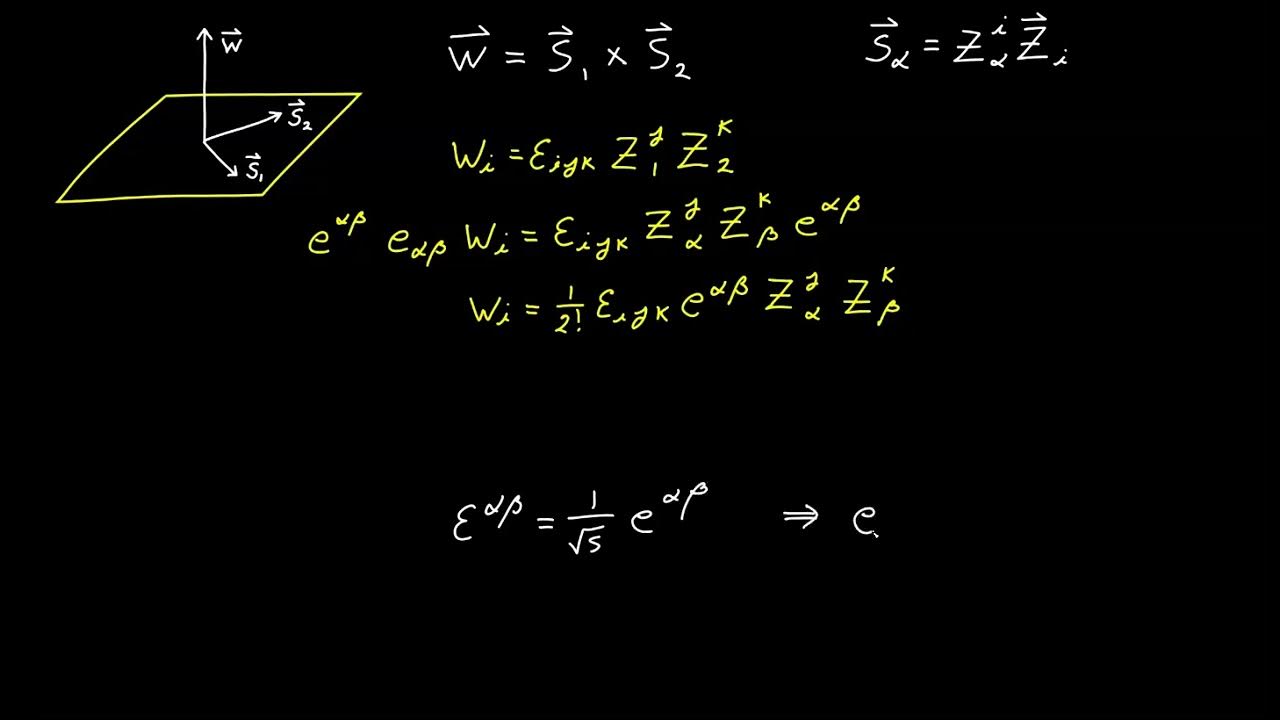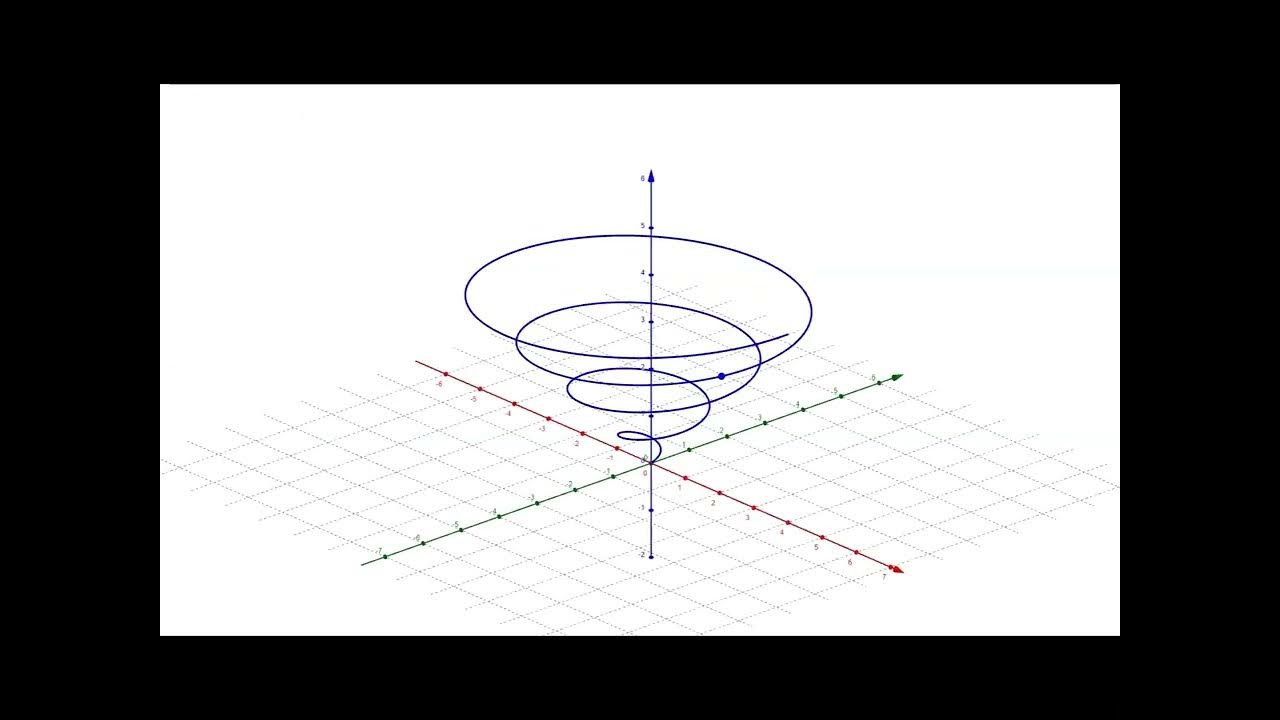Constructing a unit normal vector to a curve | Multivariable Calculus | Khan Academy
TLDRThe video script discusses the concept of vector algebra, focusing on the construction of a unit normal vector at any given point on a curve in two dimensions. It introduces the idea of a tangent vector and its relationship to the normal vector, using the negative reciprocal of the slope as a foundational concept. The script visually demonstrates how to derive the normal vector from the tangent vector by swapping the components and taking the negative of one, ultimately leading to the formula for a unit normal vector as the original vector divided by its magnitude (DS).
Takeaways
- 📌 The curve R is defined in two dimensions on the XY plane with the equation X of T times I plus Y T times J.
- 📈 The graph of curve R can be visualized and approximated in a generalized form on the coordinate axes.
- 🔍 The concept of a normal vector, specifically a unit normal vector, is introduced for a given point on the curve.
- 🤔 The process of finding a unit normal vector involves understanding the tangent vector at a point on the curve.
- 🦶 The tangent vector is constructed by considering the position vector at a given time T and as time T increases.
- 📐 The slope of the tangent line can be approximated by the difference between two vectors on the curve as the time increment decreases.
- 🛤️ The differential change in the curve, denoted as delta R, is used to represent the tangent vector at a point.
- 🔄 The tangent vector is decomposed into its horizontal (DX times I) and vertical (DY times J) components.
- ⊥ To find the normal vector, the negative reciprocal of the tangent vector's slope is used, swapping the X and Y components and changing the sign of one.
- 📏 The magnitude of the normal vector, represented as DS, is the square root of the sum of the squares of the differential changes in X and Y.
- 🌐 The unit normal vector is obtained by dividing the normal vector by its magnitude, resulting in a vector with a magnitude of one.
Q & A
What is the curve R defined as in the script?
-The curve R is defined as X of T times I, plus Y T times J, which represents a curve in two dimensions on the XY plane.
How does the script describe the graph of curve R?
-The graph of curve R is described as a curve in the XY plane, with the direction of increase being towards the right over the graph area.
What is the purpose of finding a normal vector in this context?
-The purpose of finding a normal vector is to identify a vector that is perpendicular to the curve R at any given point, with a magnitude of one, which is useful in vector algebra and calculus.
How is the tangent vector related to the curve R?
-The tangent vector is related to the curve R by approximating the slope of the tangent line at any given point on the curve, represented by the differential change in position vector (delta R) with respect to the parameter T.
What is the formula for the tangent vector DR?
-The formula for the tangent vector DR is DR = DX times I plus the infinite small change in X times the I unit vector, plus the infinite small change in Y times the J unit vector.
How can you obtain a normal vector from the tangent vector?
-To obtain a normal vector from the tangent vector, you take the negative reciprocal of the slope of the tangent line, which involves swapping the X and Y components and taking the negative of one of them.
What are the components of the normal vector?
-The components of the normal vector are DY times I minus DX times J.
How do you find the magnitude of the normal vector?
-The magnitude of the normal vector is found by taking the square root of the sum of DX squared and DY squared.
What is the unit normal vector and how is it represented?
-The unit normal vector is a normal vector with a magnitude of one. It is represented as N with a hat on top, calculated as (DY times I - DX times J) divided by the magnitude of the normal vector (DS).
How does the concept of arc length relate to the magnitude of the normal vector?
-The magnitude of the normal vector is equivalent to the arc length (DS) when considering the differential change in position vector (DR) as the absolute distance along the curve.
What is the significance of finding a unit normal vector in vector calculus?
-Finding a unit normal vector is significant in vector calculus as it provides a standardized way to analyze the perpendicular direction at any point on a curve, which is essential for various calculations and applications in multivariable calculus.
Outlines
📐 Introduction to Curve R and Vector Algebra
The paragraph introduces the concept of a curve R in two dimensions on the XY plane, defined by the equation X of T times I plus Y T times J. The speaker aims to explore the idea of a unit normal vector at any given point on the curve, which involves understanding the tangent vector first. The tangent vector is derived from the position vector at a specific time T, and the slope of the tangent line is approximated by the difference between two vectors as the time increment becomes smaller. The tangent vector is represented as DR, which can be broken down into its horizontal (DX) and vertical (DY) components. The paragraph sets the stage for further discussion on vector algebra and the construction of normal vectors in the context of curves.
🔍 Derivation of the Normal Vector
This paragraph delves into the process of deriving a normal vector from the tangent vector. The speaker explains that the normal vector is perpendicular to the tangent vector and can point in two directions. For the purpose of the discussion, the focus is on the normal vector that points to the right. The normal vector is constructed by taking the negative reciprocal of the slope of the tangent line, effectively swapping the X and Y components and changing the sign of one of them. The formula for the normal vector is presented as DY times I minus DX times J. To obtain a unit normal vector, the normal vector must be divided by its magnitude, which is calculated as the square root of DX squared plus DY squared. This process is visually represented and linked to concepts learned in algebra courses, emphasizing the connection between algebra and vector calculus.
🎯 Constructing the Unit Normal Vector at Any Point
The final paragraph summarizes the process of constructing a unit normal vector at any point on the curve. The unit normal vector, represented as N with a hat, is derived from the normal vector by dividing it by its magnitude, which corresponds to the arc length DS. The unit normal vector is a vector of magnitude one and is perpendicular to the curve at any given point, providing a tool for further analysis in vector calculus. The paragraph concludes with a visual representation of the unit normal vector, reinforcing the concepts discussed in the previous paragraphs and setting the foundation for future topics in vector calculus.
Mindmap
Keywords
💡Curve R
💡XY plane
💡Tangent vector
💡Normal vector
💡Unit normal vector
💡Vector algebra
💡Slope
💡Negative reciprocal
💡Differential
💡Magnitude
💡Arc length
Highlights
The introduction of the curve R in two dimensions on the XY plane, defined by X of T times I, plus Y T times J.
The visualization of the curve R and the direction of increase as T increases.
The concept of a unit normal vector and its significance in vector algebra.
The relationship between a tangent vector and a normal vector, and how they can be derived from one another.
The method of constructing a tangent line using the position vector and the concept of delta R.
The approximation of the slope of the tangent line through the difference between two vectors.
The concept of an infinitely small change in T (DT) and its relation to the tangent vector.
The breakdown of the differential DR into its horizontal and vertical components, DX and DY.
The derivation of the tangent vector DR from the components DX and DY.
The process of finding a normal vector by taking the negative reciprocal of the slope of the tangent line.
The visual representation of the normal vector being perpendicular to the tangent vector.
The formula for the normal vector in terms of the components DX and DY.
The method of normalizing the normal vector to obtain a unit normal vector.
The calculation of the magnitude of the normal vector, relating it to the arc length.
The final expression for the unit normal vector at any point on the curve.
Transcripts
Browse More Related Video

Unit Tangent Vector & Principal Unit Normal Vector (Calculus 3)

Video 63 - The Normal

Constructing a unit normal vector to a surface | Multivariable Calculus | Khan Academy

Vector representation of a surface integral | Multivariable Calculus | Khan Academy

Video 90 - Embedded Curves - Part 2

Equations of Planes: Vector & Component Forms | Multivariable Calculus
5.0 / 5 (0 votes)
Thanks for rating: